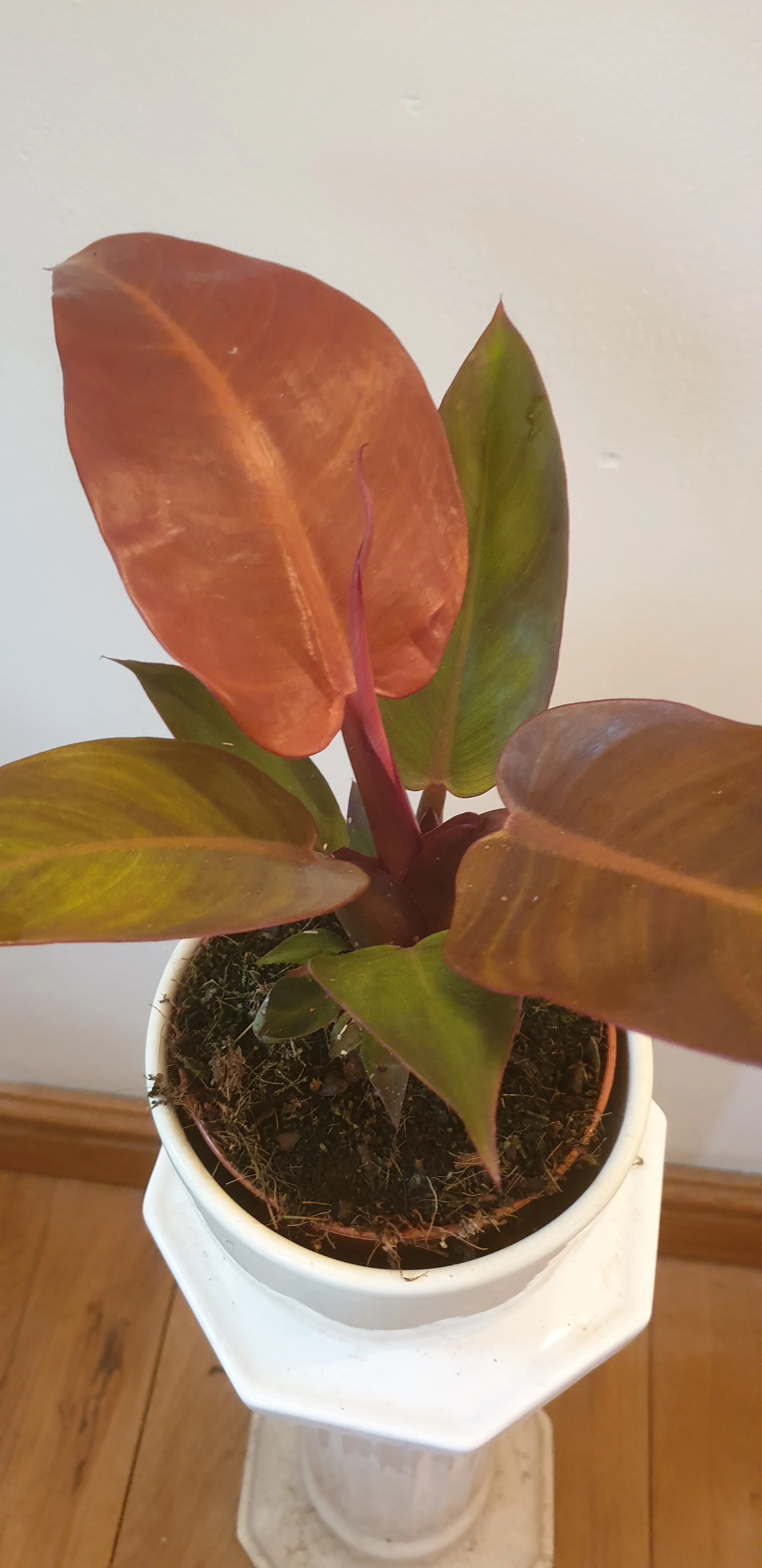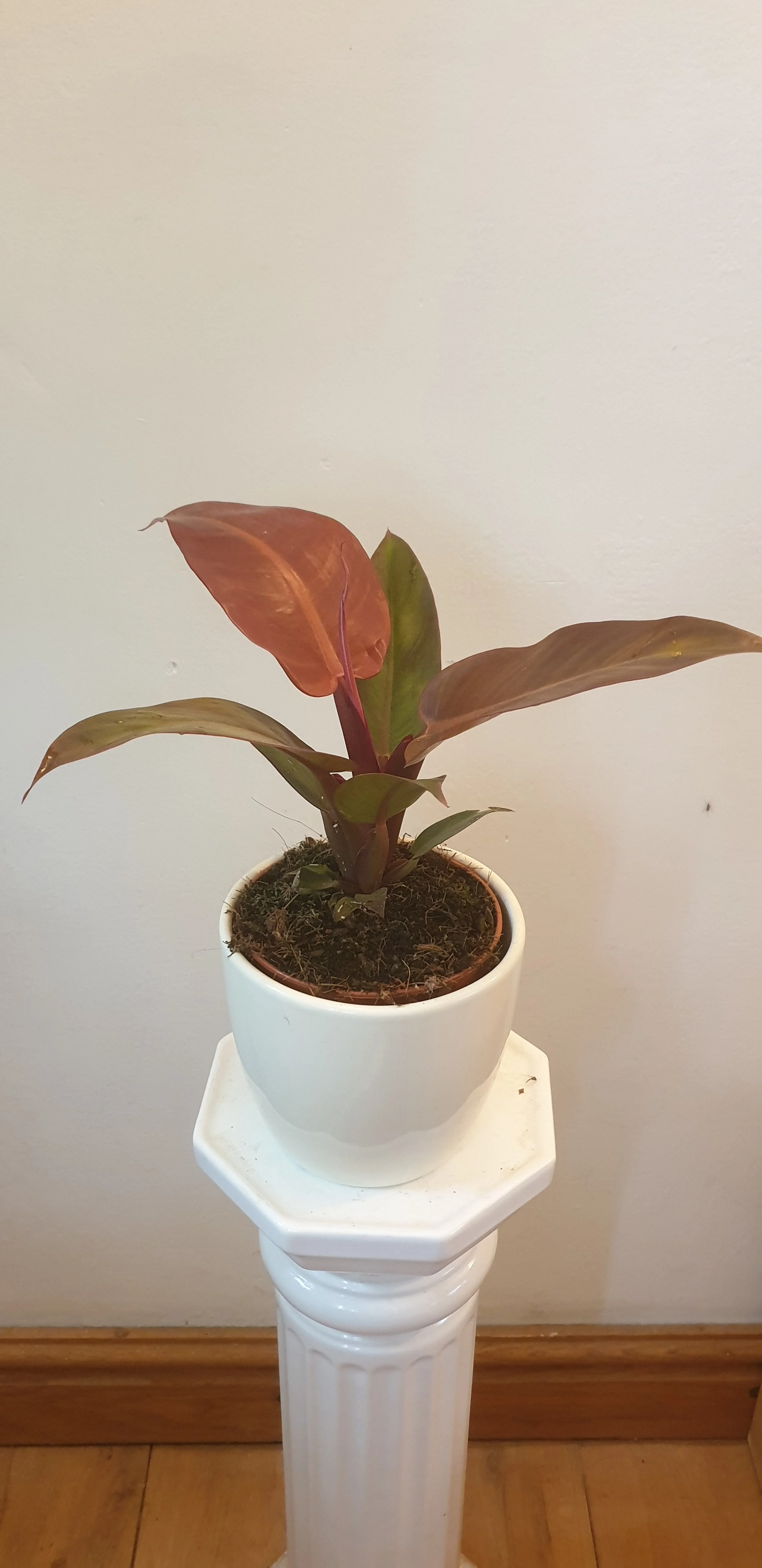 Image 1 of 2
Image 1 of 2

 Image 2 of 2
Image 2 of 2



Philodendron 'McColleys Finale' in 12cm pot.
Philodendron 'McColley’s Finale' — a hybrid philodendron known for its vibrant foliage and low-maintenance nature.
---
🌿 Philodendron 'McColley’s Finale' – Description
Botanical Name: Philodendron 'McColley’s Finale'
Family: Araceae
Type: Tropical hybrid, self-heading (non-vining) Philodendron
Native Origin: Hybrid — developed in cultivation (not found in the wild)
✅ Key Features:
Foliage: New leaves emerge in bright copper-red to orange, maturing to deep burgundy, and eventually to a rich dark green.
Leaf Shape: Smooth, elongated oval leaves with a glossy finish.
Growth Habit: Compact and self-heading — meaning it grows upright from a central base (no need for poles or support).
Size: Typically grows 1–2 ft tall (30–60 cm), and about as wide, making it great for small spaces or tabletops.
---
🪴 Care Guide for Philodendron 'McColley’s Finale'
This plant is easy to care for and adapts well to typical indoor conditions.
Aspect Ideal Conditions
Light Bright, indirect light is best to bring out vibrant colors. <br> Tolerates medium light, but new growth may be less colorful. Avoid harsh direct sun, which can scorch leaves.
Watering Water when the top 2–3 cm (1 inch) of soil is dry. <br> Keep the soil evenly moist but not soggy. Reduce watering in winter.
Humidity Prefers 50–60%+ humidity, but tolerates average indoor humidity well. <br> Mist occasionally or use a humidity tray if air is very dry.
Temperature Warm, consistent temps: 18–27°C (65–80°F). Avoid temps below 15°C (59°F). No cold drafts!
Soil Use a well-draining, chunky aroid mix: potting soil + perlite + orchid bark or coco coir. Avoid compact, water-retentive soils.
Fertilizer Feed monthly in spring/summer with a balanced liquid fertilizer, diluted to half strength. <br> Reduce feeding in fall/winter.
Repotting Repot every 1–2 years or when rootbound. Choose a pot 1–2" wider than the current one.
Pruning Minimal pruning needed. Remove old or damaged leaves to keep plant tidy.
Pests Watch for mealybugs, spider mites, and aphids. <br> Wipe leaves and treat with insecticidal soap or neem oil if needed.
---
✂️ Propagation
Best propagated via stem cuttings, though because it's a self-heading type, propagation is trickier than vining Philodendrons.
Cuttings must include a node and are best taken when repotting or dividing.
Let cuttings callous before rooting in water, moss, or soil.
---
🐾 Pet Safety
❌ Toxic to pets and humans if ingested (contains calcium oxalate crystals). Keep out of reach of cats, dogs, and small children.
---
✅ Quick Care Summary
Feature Detail
Light Bright, indirect (some filtered sun)
Water Let topsoil dry slightly between waterings
Humidity 50–60% or higher
Soil Aroid mix (chunky & well-draining)
Growth Habit Upright, self-heading (non-climbing)
Fertilizer Monthly in growing season
Toxicity Toxic to pets
Philodendron 'McColley’s Finale' — a hybrid philodendron known for its vibrant foliage and low-maintenance nature.
---
🌿 Philodendron 'McColley’s Finale' – Description
Botanical Name: Philodendron 'McColley’s Finale'
Family: Araceae
Type: Tropical hybrid, self-heading (non-vining) Philodendron
Native Origin: Hybrid — developed in cultivation (not found in the wild)
✅ Key Features:
Foliage: New leaves emerge in bright copper-red to orange, maturing to deep burgundy, and eventually to a rich dark green.
Leaf Shape: Smooth, elongated oval leaves with a glossy finish.
Growth Habit: Compact and self-heading — meaning it grows upright from a central base (no need for poles or support).
Size: Typically grows 1–2 ft tall (30–60 cm), and about as wide, making it great for small spaces or tabletops.
---
🪴 Care Guide for Philodendron 'McColley’s Finale'
This plant is easy to care for and adapts well to typical indoor conditions.
Aspect Ideal Conditions
Light Bright, indirect light is best to bring out vibrant colors. <br> Tolerates medium light, but new growth may be less colorful. Avoid harsh direct sun, which can scorch leaves.
Watering Water when the top 2–3 cm (1 inch) of soil is dry. <br> Keep the soil evenly moist but not soggy. Reduce watering in winter.
Humidity Prefers 50–60%+ humidity, but tolerates average indoor humidity well. <br> Mist occasionally or use a humidity tray if air is very dry.
Temperature Warm, consistent temps: 18–27°C (65–80°F). Avoid temps below 15°C (59°F). No cold drafts!
Soil Use a well-draining, chunky aroid mix: potting soil + perlite + orchid bark or coco coir. Avoid compact, water-retentive soils.
Fertilizer Feed monthly in spring/summer with a balanced liquid fertilizer, diluted to half strength. <br> Reduce feeding in fall/winter.
Repotting Repot every 1–2 years or when rootbound. Choose a pot 1–2" wider than the current one.
Pruning Minimal pruning needed. Remove old or damaged leaves to keep plant tidy.
Pests Watch for mealybugs, spider mites, and aphids. <br> Wipe leaves and treat with insecticidal soap or neem oil if needed.
---
✂️ Propagation
Best propagated via stem cuttings, though because it's a self-heading type, propagation is trickier than vining Philodendrons.
Cuttings must include a node and are best taken when repotting or dividing.
Let cuttings callous before rooting in water, moss, or soil.
---
🐾 Pet Safety
❌ Toxic to pets and humans if ingested (contains calcium oxalate crystals). Keep out of reach of cats, dogs, and small children.
---
✅ Quick Care Summary
Feature Detail
Light Bright, indirect (some filtered sun)
Water Let topsoil dry slightly between waterings
Humidity 50–60% or higher
Soil Aroid mix (chunky & well-draining)
Growth Habit Upright, self-heading (non-climbing)
Fertilizer Monthly in growing season
Toxicity Toxic to pets